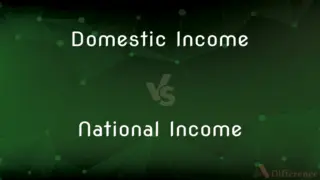Autonomous Demand vs. Derived Demand — What's the Difference?
By Tayyaba Rehman & Fiza Rafique — Published on October 24, 2023
Autonomous Demand arises from direct consumer desire, while Derived Demand results from the demand for another product or service.

Difference Between Autonomous Demand and Derived Demand
Table of Contents
ADVERTISEMENT
Key Differences
Autonomous Demand and Derived Demand are both economic concepts used to describe the nature and origin of consumer demand. Autonomous Demand pertains to the demand for goods and services generated by individual preferences, tastes, or needs. It exists independently and isn't tied to the consumption of another product. For instance, the demand for food, shelter, or clothing are often seen as autonomous because they arise from basic human necessities.
On the contrary, Derived Demand is not direct but is influenced by the demand for another product or service. It materializes because another item has demand. For instance, the demand for coal might arise from the demand for electricity. If there's a high demand for electricity, this can lead to a high demand for coal, a primary input in its production.
To further differentiate, consider Autonomous Demand as the primary or innate need, while Derived Demand is a secondary or indirect need. For instance, the demand for smartphones can be autonomous, but the demand for specific smartphone components, like semiconductors, is derived.
In economic analyses, recognizing the distinction between these two demands is crucial. Autonomous Demand can be driven by factors like population growth, cultural shifts, or income changes. Meanwhile, Derived Demand can be influenced by the fluctuations in the demand for the end product, technological changes, or production practices.
Comparison Chart
Origin
Directly from consumer preferences.
From the demand for another product/service.
ADVERTISEMENT
Example
Demand for clothing.
Demand for cotton (due to clothing).
Dependency
Independent and not tied to another product.
Tied to the demand for another product.
Influencing Factors
Population growth, income changes, cultural shifts.
Fluctuations in end product's demand, technological changes
Directness
Direct demand.
Indirect demand.
Compare with Definitions
Autonomous Demand
Arises from inherent consumer needs or desires.
The need for fresh water leads to an Autonomous Demand for bottled water.
Derived Demand
Not based on direct consumer needs but on production needs.
The growth of the paper industry results in a Derived Demand for timber.
Autonomous Demand
Rooted in fundamental human requirements.
People's need for shelter results in an Autonomous Demand for housing.
Derived Demand
Exists because of its connection to another product.
The success of smartphones causes a Derived Demand for mobile apps.
Autonomous Demand
Independent demand primarily driven by consumer choices.
As health awareness grows, there's an Autonomous Demand for organic foods.
Derived Demand
A secondary demand influenced by another primary demand.
As electric vehicles gain popularity, there's a Derived Demand for lithium batteries.
Autonomous Demand
Originates from direct individual preferences or tastes.
Fashion trends can spur Autonomous Demand for specific clothing items.
Derived Demand
Emerges due to the demand for another good or service.
The demand for tires is a Derived Demand stemming from the automobile industry.
Autonomous Demand
Not influenced by the demand for other products.
The Autonomous Demand for cars exists irrespective of the demand for car parts.
Derived Demand
Indirect demand tied to another product's consumption.
Construction growth leads to a Derived Demand for cement.
Common Curiosities
Why is Derived Demand called "derived"?
Because it originates from the demand for another product or service.
What drives Autonomous Demand?
Autonomous Demand is driven by direct consumer preferences, needs, or desires.
How does technological advancement affect Derived Demand?
It can increase demand for specific components or decrease demand for outdated ones.
Can Autonomous Demand be influenced by Derived Demand?
Typically, no. Autonomous Demand is independent, while Derived Demand is secondary.
If a product has both types of demand, which is dominant?
It depends on the product and market, but usually Autonomous Demand is more foundational.
Does Derived Demand affect supply chain decisions?
Yes, businesses must anticipate and manage Derived Demand to ensure adequate supply.
How can businesses anticipate changes in Derived Demand?
By monitoring trends and shifts in the primary product's market.
Is the demand for luxury items Autonomous Demand?
Yes, if driven by individual tastes and not contingent on another product's demand.
Can a decrease in Autonomous Demand for a product affect its Derived Demand?
Yes, if the primary product's demand decreases, its Derived Demand likely will too.
Can a single product experience both types of demand?
Rarely, but it's possible if the product serves both a primary need and supports another product's demand.
What's an example of Derived Demand in the tech industry?
The demand for computer chips arises from the demand for computers.
Can Autonomous Demand ever become Derived Demand?
Not typically, as the nature of Autonomous Demand is to be primary and independent.
Does marketing primarily target Autonomous or Derived Demand?
Marketing usually targets Autonomous Demand, but B2B marketing can focus on Derived Demand.
How does economic downturn affect these demands?
Autonomous Demand for essentials remains, but luxury items might decrease, affecting their Derived Demand.
Are there products with only Derived Demand?
Yes, some products exist solely because of the demand for another, like specific machine parts.
Share Your Discovery

Previous Comparison
Domestic Income vs. National Income
Next Comparison
Emollient vs. OcclusiveAuthor Spotlight
Written by
Tayyaba RehmanTayyaba Rehman is a distinguished writer, currently serving as a primary contributor to askdifference.com. As a researcher in semantics and etymology, Tayyaba's passion for the complexity of languages and their distinctions has found a perfect home on the platform. Tayyaba delves into the intricacies of language, distinguishing between commonly confused words and phrases, thereby providing clarity for readers worldwide.
Co-written by
Fiza RafiqueFiza Rafique is a skilled content writer at AskDifference.com, where she meticulously refines and enhances written pieces. Drawing from her vast editorial expertise, Fiza ensures clarity, accuracy, and precision in every article. Passionate about language, she continually seeks to elevate the quality of content for readers worldwide.












































